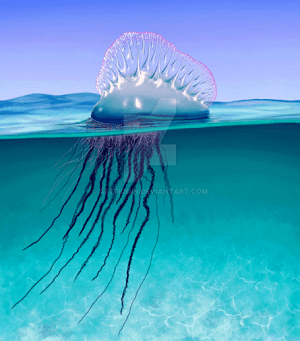Home › A-Z Scuba Guide › Common Diving Injuries › Portuguese Man O' War
First Aid for Portuguese Man O' War Sting
The Portuguese man-of-war species are actually hydrozoans, but the recommended treatment for Bluebottle stings is similar to the remedies used to treat jellyfish stingers.
This guide explains the signs and symptoms of passive envenomation and the recommended first aid treatment for Portuguese man o' war sting.
Portuguese Men-of-War are Not Jellyfishes
It's easy to see why some people think these creatures belong with the jellyfish species (Scyphozoa).
However, the Portuguese man-of-war are Siphonophora - meaning they are a class of hydrozoans.
Here's the thing:
They certainly look like sea jellies. But, they are actually closer related to fire coral and stinging hydroids.
The blue gas-filled bladder and long flowing tentacles help Portuguese man-of-war float freely with ocean currents. But, making contact with the tentacles of these cnidarians can cause intense pain and other symptoms that can affect the entire body.
Where Do Portuguese Man O' War Live?
The genus contains two species. Physalia physalis (Portuguese man-of-war) prefers the cold waters of the Atlantic Ocean. The other species, Physalia utriculus (bluebottle) inhabits the warmer waters of the Indo-Pacific.
The appearance and characteristics of the Portuguese man-of-war are deceiving. The specimen might look like it's a single creature to the untrained eye. But in fact it is a colony made up of four different types of polyps.
How to Prevent Marine Envenomation
The most likely place to encounter the submerged tentacles of cnidarians is the final three metres before you reach the surface. So, always look up and check around while surfacing after a dive.
The mechanical protection divers and swimmers get from wearing a full-body exposure suit helps to protect human skin against jellyfish stings and rashes.
In warm-water environments where cnidarians are present, it's best to wear a thin rash guard or a hooded vest for extra protection of your ears, neck, and face.
Portuguese Man-of-War Sting Symptoms
Their cnidocytes deliver a potent proteic neurotoxin, which can easily paralyse small fishes. But, the risk of scuba divers getting stung is low, because most of the stings from Physalia occur at the surface or on the beaches.
The sting site may swell and you may see red slashes or welts. Besides suffering moderate to severe pain for a few days, other common symptoms of Portuguese man o' war sting include:
 Blurred vision
Blurred vision- Burning pain
- Diarrhoea
- Dizziness
- Fever
- Malaise and muscle weakness
- Muscular cramps (especially in the back and abdomen)
- Nausea
- Shortness of breath
- Skin blisters and lesions
- Sweating
- Tachycardia (elevated heart rate at rest)
- Vomiting
Important: Some people develop a severe allergic reaction to the Portuguese man-of-war's venom. If so, there may be some interference with the normal cardiac and respiratory function. Always seek prompt evaluation from medical professionals.
Treatment for Portuguese Man-of-War Sting
Even though the initial pain is likely to be intense for a few hours, these kinds of diving injuries rarely lead to life-threatening complications. But, monitor the patient's circulation, airway, and breathing, in case cardiopulmonary resuscitation (CPR) becomes necessary.
1. Avoid Rubbing the Affected Area
The tentacles of cnidarians are coated with nematocysts (stinging cells). So, if you rub the area the tentacles may roll over parts of unaffected skin. Hence, doing so will worsen the envenomation process.
2. Removing Man O' War's Tentacles
Use gloves or tweezers to try and remove any visible tentacles. There is a protein inside human skin cells, called keratin. This layer of keratin is usually thick enough to provide some protection (e.g. if you don't have gloves to protect you).
Pro Tip: Your fingers may have come in contact with thousands of unfired nematocysts after removing man-of-war tentacles from an injured diver.
3. Flush Damaged Skin with Seawater
After removing the tentacles (and any physical remnants), try to flush the affected area with a powerful stream of seawater. It will help to remove any unfired nematocysts.
Important: Do not flush the stings with fresh water. Doing so causes unfired nematocysts to start firing (through a process called cytolysis).
4. Apply White Household Vinegar
A good method used to stabilise unfired nematocysts is the application of white household vinegar. You might also use a mild acetic-acid solution of about 3% in water.
Even though the vinegar won't help injected venom, it's a rescue technique for preventing further envenomations.
5. The Benefits of Applying Heat
Often, the application of heat can help to mask the perception of pain. Plus, heat (e.g. hot water) might also help to break down hazardous substances (via thermolysis) to denature toxins.
- If you immerse an affected area in hot water, it must not be hotter than 45° Celsius (113° Fahrenheit) and for no more than ninety (90) minutes. Test the heat level of the water on yourself first and do not rely on a test for tolerable temperature from the victim.
- Repeat as often as is necessary. You can also apply a cold pack (e.g. ice inside a dry plastic bag) if hot water is unavailable. Always try to seek a higher level of care and professional medical evaluation.
5. Monitoring the Diver
Injuries from Physalia physalis (Portuguese man-of-war bluebottle) might cause intense systemic symptoms. Thus, look for signs of shock in severe cases or in envenomations involving children.
Using Vinegar for Physalia Stings
The current guidelines issued by the American Heart Association (AHA 2015) still recommend using the application of vinegar for all jellyfish stings (including Physalia spp).
Related Information and Help Guides
- Blue Ringed Octopus Bite Symptoms and First Aid
- Fish Spine Injury First Aid Treatment
- Jellyfish Sting: Stinging Hydroids and Coral Anemones
- How to Treat Crown of Thorns Starfish Sting
- Symptoms and Treatment for Cone Snail Sting
Note: The short video [2:53 seconds] presented by Deep Marine Scenes contains stunning footage of the Portuguese man of war (bluebottle).